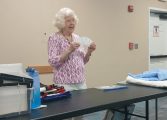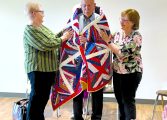By Page H. Gifford
Correspondent
During his visit with members of the Fluvanna Art Association, artist Bob Anderson discussed his artistic and varied lifestyle. Not many McGuffey Art Center artists have ties in Fluvanna but Anderson had been good friends with one of the original FAA founders, the late Alice Clifford and her family. Clifford’s husband was instrumental in helping Anderson bring his French wife to the U.S. Anderson was also a great admirer of Alice Clifford’s work.
Architect turned artist and illustrator, he has based his work on the various places he lived and visited throughout the world. Born and raised in a military family, Anderson spent his early years in Hawaii and later grew up in Washington D.C. He met his wife while traveling abroad and both live part-time in Brittany off the coast of France near their children.
Many influences in Anderson’s work derive from his time spent in Costa Rica and Africa. Both have a special fascination for him. The variegated green colors of a tangled forest in Costa Rica featured in a life-size oil painting or the detailed jungle scenes with a wide range of African species are reminiscent of the work of illustrator Maurice Sendak.
“I began drawing when I was four,” he said. “And I was always influenced by the work of Albrecht Durer, old books, and etchings.” But he said comic books and MAD Magazine also were a draw for him. When he added writing to his list of accomplishments, these influences carried over into his novels. A modern Renaissance man with many interests, he is a sculptor as well.
“When I work on illustrations, I print up the drawing on my actual drawing paper and have another copy I work on simultaneously with the final drawing.” This helps an artist see how the drawing takes shape and how colors interact to create a whole.
Anderson’s other work done in pen and ink was in book form but exhibited on a much larger scale. One model who was in a catlike pose, moving toward the viewer was originally “four feet by four feet.” Members were goggle-eyed at the prospect of accomplishing this with such precise detail, every dot and line creating the final image. Nowadays, pen and ink are just a pen with a razor sharp point from .01 to .08 for various line thicknesses. In the old days, it was assorted nibs and bottles of ink and brushes. One must have patience to work in this medium since it can be a tedious process but for many artists it’s therapeutic.
He uses some unique techniques in his work to achieve a certain look.
“For colors, I will use markers, mostly grays, and then go over them with colored pencil,” he said. “And I also use graphite with pen and ink.” This gives an artist options for creating a certain look.
“I work from photographs but also Plein Air and I don’t use everything that is in the photo but use or remove certain things.” By using this method, Anderson creates something unique and original by using certain elements without copying the entire photo with everything featured. In one of his examples of a pen and ink of a live model surrounded by mirrors, Anderson took a different approach by adding eclectic items in his drawings rather than just the reflections of the model, blending realism with abstraction. Currently, he is working on a piece that measures 7 feet by 50 inches featuring a tree.
“I could only see the bottom so I made up the rest.”
Many artists would be surprised to learn that Anderson is a successful artist who does not have a formal art degree. Many artists show exceptional talent and are encouraged to study and practice and for this reason many good artists are self-taught.
“I have not had any formal training in art other than the few classes in drawing, watercolor, sculpting, and photography I took when studying architecture but I had one teacher that turned me on. He encouraged individualism rather than everyone having to do it his way or the right way he told me to move in my direction.”




